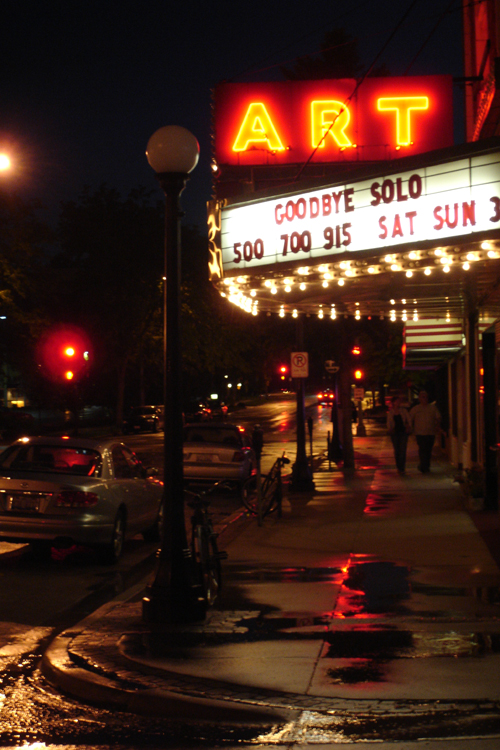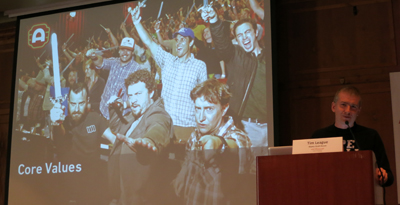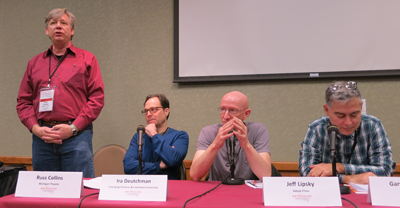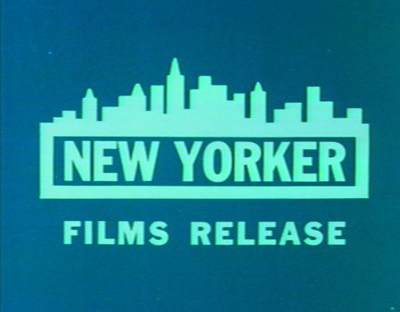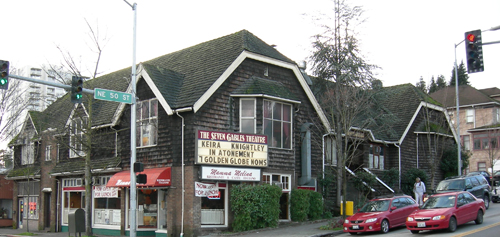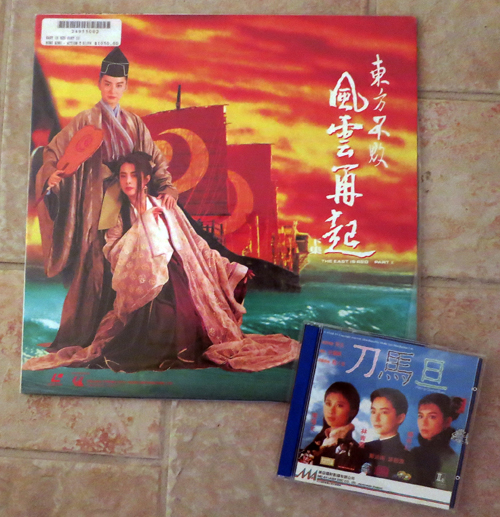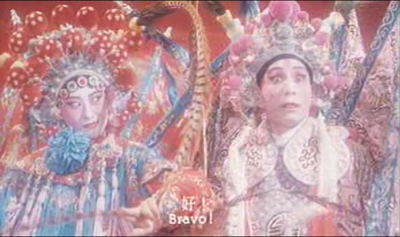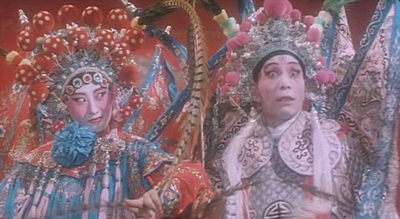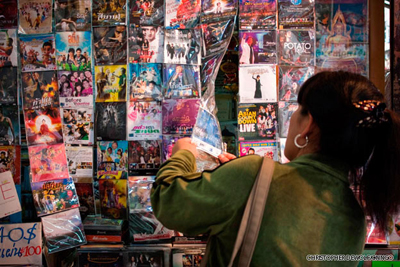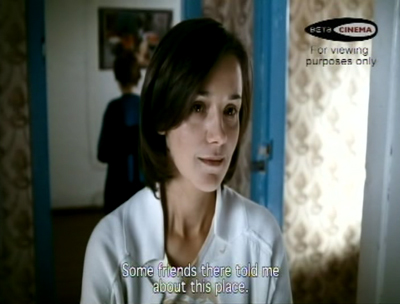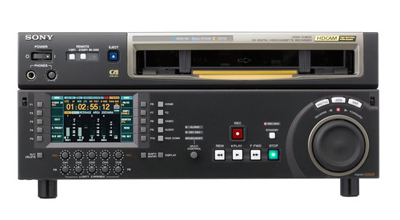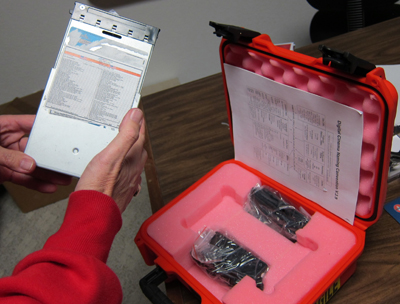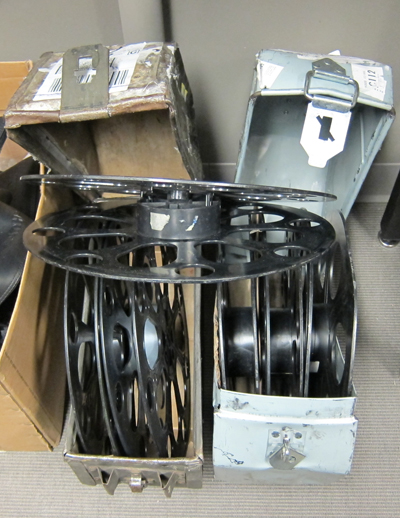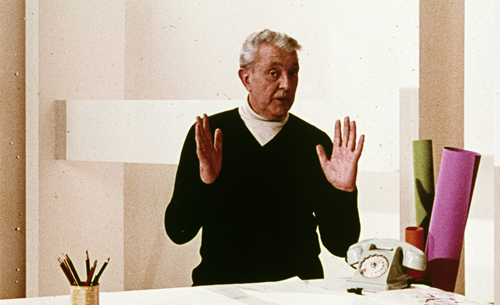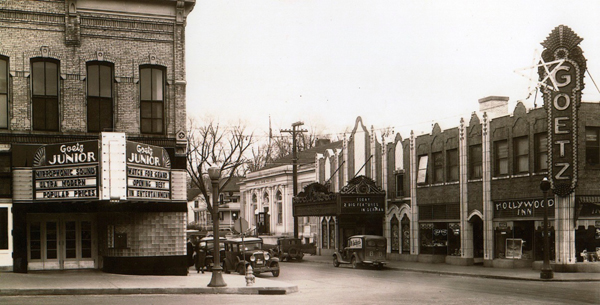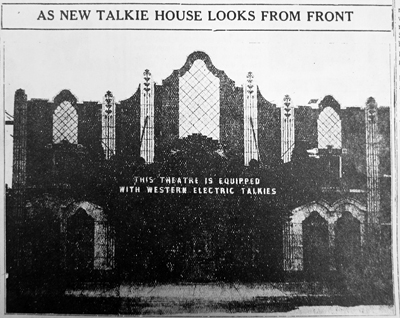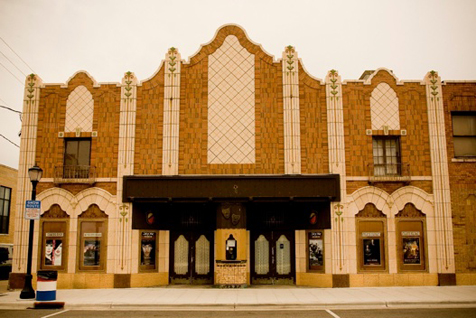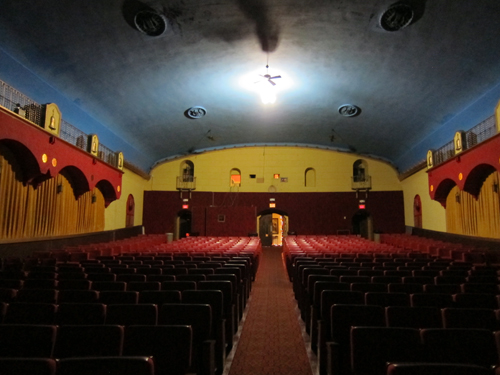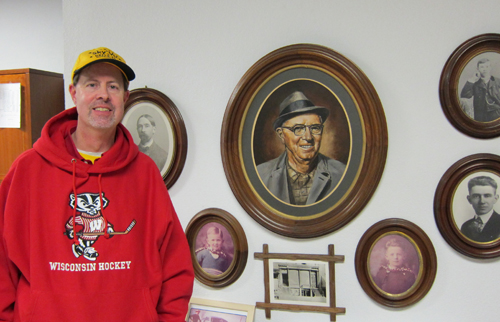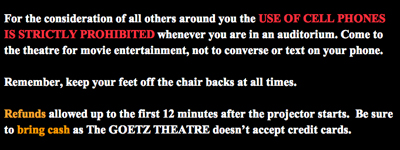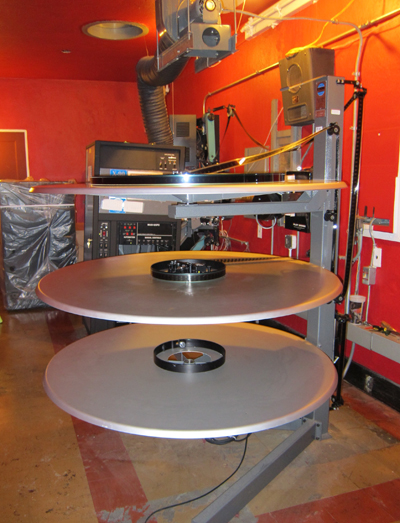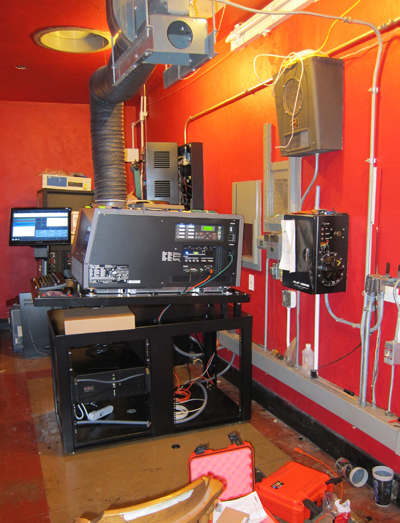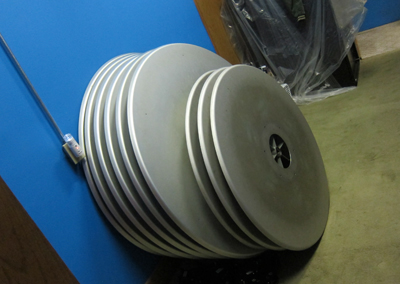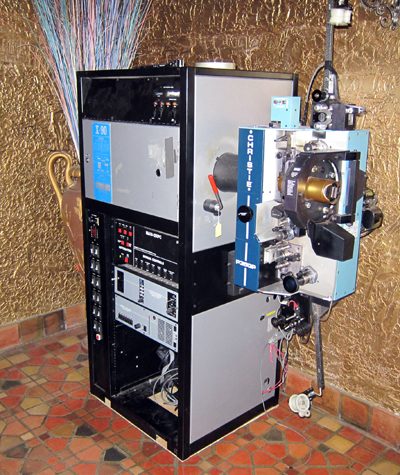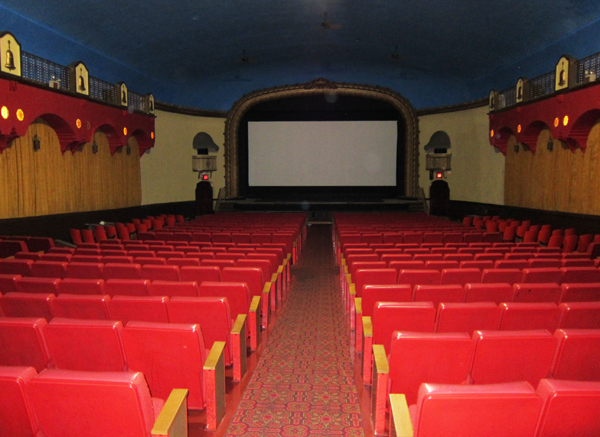Archive for the 'Digital cinema' Category
Pandora’s digital box: Art house, smart house
The Art Theater, Champaign, Illinois. Photo by Sanford Hess, reproduced with permission.
DB here:
Theatres’ conversion from 35mm film to digital presentation was designed by and for an industry that deals in mass output, saturation releases, and quick turnover. A movie comes out on Friday, fills as many as 4,000 screens around the country, makes most of its money within a month or less, and then shows up on VoD, PPV, DVD, or some other acronym. The ancillary outlets yield much more revenue to the studios, but the theatrical release is crucial in establishing awareness of the film.
Given this shock-and-awe business plan, movies on film stock look wasteful. You make, ship, and store several thousand 35mm prints that will be worthless in a few months. (I’ve seen trash bags stuffed with Harry Potter reels destined for destruction.) Pushing a movie in and out of multiplexes on digital files makes more sense.
After a decade of preparation, digital projection became the dominant mode last year. Today “digital prints” come in on hard drives called Digital Cinema Packages (DCPs) and are loaded (“ingested”) into servers that feed the projector. The DCPs are heavily encrypted and need to be opened with passkeys transmitted by email or phone. The format is 2K projection, more or less to specifications laid down by the Digital Cinema Initiatives (DCI) group, a consortium of the major distributors.
Upgrading to a DCI-compliant system can cost $50,000-$100,000 per screen. How to pay for it? If the exhibitor doesn’t buy the equipment outright, it can be purchased through a subsidy called the Virtual Print Fee. The exhibitor can select gear to be supplied by a third party, who collects payment from the major companies and applies it to the cost of the equipment. The fee is paid each time the exhibitor books a title from one of the majors. See my blogs here and here for more background.
It’s comparatively easy for chains like Regal and AMC, which control 12,000 screens (nearly one-third of the US and Canadian total), to make the digital switchover efficiently. Solid capitalization and investment support, economies of scale, and cooperation with manufacturers allow the big chains to afford the upgrade. But what about other kinds of exhibition? I’ve already looked at the bumpy rise of digital on the festival scene. There are also art houses and repertory cinemas, and here one hears some very strong concerns about the changeover. “Art houses are not going to be able to do this,” predicts one participant. “We will lose a lot of little theatres across the country.”
The long, long tail
‘Plexes, whether multi- or mega-, tend to look alike. But art and rep houses have personality, even flair.
One might be a 1930s picture palace saved from the wrecking ball and renovated as a site of local history and a center for the performing arts. Another might be a sagging two-screener from the 1970s spiffed up and offering buns and designer coffees. Another might look like a decaying porn venue or a Cape Cod amateur playhouse (even though it’s in Seattle). The screen might be in a museum auditorium or a campus lecture hall. When an art house is built from scratch, it’s likely to have a gallery atmosphere. Our Madison, Wisconsin Sundance six-screener hangs good art on the walls and provides café food to kids in black bent over their Macs.
Most of these theatres are in urban centers, some are in the suburbs, and a surprising number are rural. Most boast only one or two screens. Most are independent, but a few belong to chains like Landmark and Sundance. Some are privately held and aiming for profit, but many, perhaps most, are not-for-profit, usually owned by a civic group or municipality.
What unites them is what they show. They play films in foreign languages and British English. They show independent US dramas and comedies, documentaries, revivals, and restorations.
In the whole market, art houses are a blip. Figures are hard to come by, but Jack Foley, head of domestic distribution for Focus Features, estimates that there are about 250 core art-house screens. In addition, other venues present art house product on an occasional basis or as part of cultural center programming.
Art house and repertory titles contribute very little to the $9 billion in ticket sales of the domestic theatrical market. Of the 100 top-grossing US theatrical releases in 2011, only six were art-house fare: The King’s Speech, Black Swan, Midnight in Paris, Hanna, The Descendants, and Drive. Taken together, they yielded about $309 million, which is $40 million less than Transformers: Dark of the Moon took in all by itself. And these figures represent grosses; only about half of ticket revenues are passed to the distributor.
More strictly art-house items like Take Shelter, Potiche, Bill Cunningham New York, Senna, Snow Flower and the Secret Fan, Certified Copy, Page One, The Women on the 6th Floor, and Meek’s Cutoff took in only one to two million dollars each. Other “specialty titles” grossed much less. Miranda July’s The Future attracted about half a million dollars, Uncle Boonmee Who Can Recall His Past Lives grossed $184,000, and Godard’s Film Socialisme took in less than $35,000. For the distributors, art films retrieve their costs in ancillaries, like DVD and home video, but the theatres don’t have that cushion.
Something else sets the art and rep houses apart from the ‘plexes: The audience. It’s well-educated, comparatively affluent, and above all older. Juliet Goodfriend’s survey of art house operators indicates that only about 13% of patrons are children and high-school and college students. The rest are adults. A third of the total are over sixty-five. As she puts it, “Thank God for the seniors!” However much they like popcorn, they love chocolate-covered almonds.
Almonds aside, how will these venues cope with digital? To find out, I went to Utah.
Harmonic Convergence
Tim League, Alamo Draft House, during his keynote address at the Art House Convergence.
Five years ago, the Sundance Institute founded the Art House Project, a group of theatres that could screen a tour of Sundance Festival films. The original members recognized the advantages of collaborating, and Russ Collins of the Michigan Theatre organized an annual meeting held just before the festival. In its first year, 2008, the Art House Convergence attracted twenty-two people. This year it drew nearly three hundred—not only programmers and operators and major speakers, but delegates from distribution companies, service firms, and equipment manufacturers. To my eye, it’s becoming an informal trade association.
My three and a half days at the Convergence in Midway, Utah filled me with information and energy. Having attended one of the classic art theatres in my youth, the Little Theatre in Rochester, New York, I’ve been a patron in this sector for fifty years. But I never really met the people behind the scenes. This bunch is exuberant and committed to sharing their love of cinema. They want to watch a movie surprise and delight their audiences. Ideally, the customers would so completely trust the programmer’s judgment that they would come to that theatre without knowing what’s playing.
If you wonder where old-fashioned movie showmanship went, look here. These folks mount trivia contests, membership drives, singalongs. They help out with local film festivals. They bring in filmmakers and local experts for Q & A sessions. They screen those plays, operas, ballets, and concerts that attract a broader arts audience. The bigger entities, like the Bryn Mawr Film Institute and the Jacob Burns Film Center, offer courses in filmmaking and appreciation, along with special events for children, teenagers, and other sectors of the community.
Everything is about localism. These people know their customers, often by name. They sense the currents of taste crisscrossing their town. The success of the Alamo Draft House reveals that Austin has a demographic hungry for the kung-fu classic Dreadnaught, an Anchorman quote-along, or a compilation of the worst CGI work in film history. In LA, The Cinefamily attracts a crowd ready to watch Film Socialisme alongside Battle Royale, Pat O’Neill films, and the 1927 Casanova. “Mission” was a word heard often heard in Midway. These people aren’t only about making money but about weaving unusual cinema into the fabric of their town’s culture and subcultures.
The classic art house was mission-driven too, and it could pay a little as well. Before the advent of videotape, you could make decent money showing Ealing comedies, Fellini, and Bergman years after their initial release. Some exhibitors continue as profit-driven businesses. But many, perhaps most, people in the Project operate not-for-profit venues. The cinemas are funded by donations, foundations, and government agencies, such as arts councils. Russ Collins has argued for embracing this trend.
“New model” Art House cinemas are community-based and mission-driven. . . . Most “new model” Art House cinemas are non-profit organizations managed by professionals who are expert in community-based cinema programming, volunteer management and the solicitation of philanthropic support from local cinephiles and community mavens.
Russ points out that over the twentieth century, opera, theatre, and other sectors of the performing arts have moved toward non-profit status. “If it makes sense that if music has a range from very commercial to very subsidized, film should too. There are all kinds of movies, and there should be all kinds of outlets.” The University of Wisconsin–Madison Cinematheque and the Wisconsin Film Festival have shown me that this strategy can work—again, if the programming meshes with the tastes of its community.
There are clouds on the horizon, of course. Gary Palmucci of Kino Lorber recalled a line from Irvin Shapiro, who distributed foreign-language films for fifty years: “When were there ever not problems?”
For example, the baby-boomers, cinephiles since the ‘60s, are likely to be around for ten or fifteen more years. Where will new patrons come from? When I was in college, you scheduled your life around theatres’ showtimes, but younger people have gotten used to time shifting and on-demand access via tape, disc, cable, or the Web. A more worrisome sign: even in art houses near college campuses, students tend to make up a small fraction of the audience. The next few years will tell if changed tastes, along the habit of unbridled access to movies, will keep an aging Gen X from the art house.
More pressing the problem is digital conversion. It was the topic of two information-filled sessions at the Convergence, and it came up often during other panels.
Where do they get those movies?
An AHC panel: Russ Collins, Ira Deutchman (Emerging Pictures), Jeff Lipsky (Adopt Films), and Gary Palmucci (Kino Lorber).
Historically, most major new film technology was introduced in the production sector and resisted in the exhibition sector. Exhibitors have been right to be conservative. Any tinkering with their business, especially if it involves massive conversion of equipment and auditoriums, can be costly. If the technology doesn’t catch on, as 3D didn’t in the 1950s, millions of dollars can be wasted.
Shooting movies on digital was no threat to theatres as long as 35mm prints were the standard for screening. But distribution has long been the most powerful and profitable sector of the film industry. Today’s major film companies—Warners, Paramount, Sony et al.—dominate the market through distribution. So when the Majors established the Digital Cinema Initiatives (DCI) standards, exhibitors had to adjust.
Since distributors call the tune, let’s look at the different digital alternatives available.
Mainstream commercial films from the major studios are currently distributed in both 35mm copies and digital copies. But at some point fairly soon, the majors will cease releasing 35mm. Twentieth Century Fox has taken the lead in declaring that at the end of this year it will circulate no more film prints. John Fithian, the plain-spoken President of the National Association of Theatre Owners, said in March of 2011:
Based on our assessment of the roll-out schedule and our conversations with our distribution partners, I believe that film prints could be unavailable as early as the end of 2013. Simply put, if you don’t make the decision to get on the digital train soon, you will be making the decision to get out of the business.
This means that the theatre will require full 2K/4K projection, and the exhibitor will need a DCI-compliant projector and a server for every screen. To pay for the upgrade, many exhibitors will want to take advantage of the Virtual Print Fee. But many VPF programs have set their signup deadlines during this year.
Arthouse films distributed by studio subsidiaries are the tentpoles and blockbusters of the arthouse market. Sony Pictures Classics, Universal Focus, and Fox Searchlight usually furnish the most desirable pictures for these screens. Add in certain titles supplied by “mini-majors” like Relativity, The Weinstein Company, and Lionsgate/ Summit. This season, for instance, art houses would have suffered without Tinker Tailor Soldier Spy (Focus), The Descendants (Fox Searchlight), A Dangerous Method and The Skin I Live In (SPC), and The Iron Lady, The Artist, and My Week with Marilyn (Weinstein).
As far as I can determine, all these firms currently supply 35mm prints. Jack Foley of Focus recognizes that film copies remain the default for most art houses. For Focus, 35mm circulation makes sense because many films play widely enough and roll out slowly enough to amortize print costs.
Focus will be patient with its core customers and their financial challenges in going digital. . . . Supplying them with 35mm in the meantime allows us to play them and play them cheaply by using prints multiple times at no cost more than shipping.
But studio subsidiaries must also provide the DCI-compliant Digital Cinema Packages. Some art houses have converted and can handle them. More important, many of these films play in “smart houses.” These are screens, located in a mainstream multiplex, that will show films that get good response in art-house runs. If a movie has crossover appeal, a smart house can hold it long enough to build word of mouth. Right now, several multiplexes are playing Tinker Tailor, The Descendants, My Week with Marilyn, and the like. There are, Jack Foley estimates, between 250 and 500 screens of this sort in the country.
Smart houses, as parts of multiplex circuits, are usually showing DCPs. At the moment, Foley points out, the Virtual Print Fee is onerous for non-major distributors, since if they supply a DCP to a theatre, they must pay the fee (often about $850). Foley believes that eventually all viable art houses will convert to DCI projection, the VPFs will expire, and every party will reap the benefits of digital cinema.
Films distributed by smaller, independent distributors offer still other options. These are companies like Kino Lorber, IFC, Magnolia, Strand, Roadside Attractions, Oscilloscope, Zeitgeist, and their peers. They circulate the most offbeat product, dramas like The Messenger and Meek’s Cutoff (Oscilloscope), along with documentaries and foreign titles like Cave of Forgotten Dreams, Pina, and Certified Copy (IFC) and 13 Assassins (Magnolia). Restorations and reissues of classics, such as Metropolis (Kino Lorber) and On the Bowery (Milestone), operate in this sector as well. Like their studio counterparts, these firms need the video aftermarket to support purchasing theatrical rights.
Some of these distributors supply 35mm prints, like Magnolia’s very pretty one of Melancholia that I saw in Madison a few weeks ago. But most Virtual Print Fee agreements apparently demand that if a non-Majors film arrives on DCP and is to be played on a projector financed through the VPF, the independent distributor must chip in the fee. Some are willing to do that.
What surprised me most was learning that independent distributors will supply the film in many digital formats, even Blu-ray and DVD versions. There are now first-run films playing commercial theatres, even in Manhattan, in Blu-ray. On small screens, many exhibitors say, that format works fine and their patrons don’t notice. Many of these films aren’t available on 35mm prints at all, although a distributor may prepare a print if there’s enough interest to help pay for it.
A lateral option, sometimes called i- or e-cinema, also exists. There are now companies offering theatre delivery via the Internet. The idea is to stream encrypted files, in HD, to cinemas signed onto the system. Emerging Pictures, currently the dominant player in this domain, will deliver material from many independent distributors, including Sony Classics, IFC, and Magnolia. Emerging will also supply performing arts shows. Other companies offering or preparing to offer comparable services are Specticast, Proludio and Storming Images.
Summing up: If an art house wants to show only films from the independent, second-tier distributors, then the pressure to convert to DCI isn’t great. The exhibitor will, however, be playing more and more movies on DVD or Blu-ray. But the fact is that one Iron Lady pays for a lot of Take Shelters. The need to show art house blockbusters will eventually push most art-house operators toward buying or leasing the high-end equipment.
In between
Juliet Goodfriend, Art House Convergence. Photo by Chuck Foxen, reproduced with permission.
The new digital problems confronting the art-house market don’t end with decisions about equipment.
For one thing, DCP playback creates a degree of inflexibility that festivals have also encountered. Shifting showtimes and screens is more difficult, as it may require special permission and a new key to open the file. There is, moreover, an air of surveillance that is inimical to the more informal, trust-based atmosphere of most art-cinema milieus.
More constraints appear if the exhibitor chooses to fund the changeover through the Virtual Print Fee. For example, VPFs oblige the exhibitor to screen only films supplied by the major companies–the ones that created the Digital Cinema Initiatives. If an exhibitor wants to play an independent distributor’s title on a DCP, that distributor needs to pay the fee, in effect helping to cover the theatre’s conversion. Other constraints are more obscure. I can’t report reliably on them because when joining a VPF program, the exhibitor signs a non-disclosure agreement pledging not to reveal details of the deal. But hints suggest that exhibitors could be prevented from “splitting,” that is showing two or more films in the same auditorium on one day. This is a practice that many art cinemas rely on because it allows them to vary programs in mid-week, or to compensate for having only one or two screens.
Another effect of the digital revolution comes from streaming, or Video on Demand. Many of the most desirable films from independent distributors are released on VoD simultaneous with or even before theatrical release. At the Convergence, one exhibitor pointed out that Melancholia was available on VoD several weeks before she could play it on her screen.
Distributors offer several justifications for their streaming decisions. Ancillary income from DVD has declined steeply, and VoD pays well. According to Josh Dickey’s Variety article and Daniel Miller’s Hollywood Reporter piece on the rise of VoD deals, Margin Call, which attracted $5.3 million theatrically, took in an estimated $4-$5 million on VoD. Another advantage is that streaming provides fast returns, while any DVD income won’t show up for many months. Moreover, VoD can reach audiences in areas of the country that don’t have art houses. And some distributors believe that the theatrical and VoD audiences don’t significantly overlap. For Margin Call, it’s claimed, most people who saw it in the theatre didn’t know that it was on VoD, and many who caught it on VoD would not have gone to a theatre.
There don’t seem to be any firm conclusions about how much day-and-date or early release on VoD can harm a film’s theatrical release. In the absence of detailed evidence about VoD grosses, exhibitors are understandably nervous.
Finally, what about access to older films in studio collections? These titles are central to repertory cinemas, and many art houses that play recent releases schedule some classics too. Yet some studios are increasingly reluctant to supply 35mm prints from their libraries. If the film isn’t on DCP, exhibitors may be told that they must pay to have a DCP made, or show a Blu-ray or DVD. But repertory cinemas are reluctant to screen on the low-resolution formats, and rarer and more obscure titles are unlikely to be available on disc. Unhappily, we may get less repertory programming on the whole. Audiences that don’t live in a town with an archive or cinematheque will have less chance to discover film history.
A tradition, forced to reconfigure
The energetic arts entrepreneurs who gathered at Midway can claim a proud tradition. The art-house and repertory model of exhibition, originating in the 1920s, came to prominence after World War II. These theatres played imported films from small distributors, with occasional independent items mixed in. A 1949 Variety article noted that the market had a boom that was starting to level off.
Postwar surge of art theatres, born as an outlet for the flock of British and foreign-lingo pix which hit this country after V-J Day, is now slowing to a normal growth. In the U. S. at the present time there are 57 theatres which are out-and-out art houses and 226 additional flickeries which play foreign-made product part of their time. . . . With the exception of Newark. . . every city of 200,000 or over now sports at least one art theatre.
Then as now, these theatres offered a more personal atmosphere and upscale service (tea, coffee). Like today’s art houses, they depended on what we call buzz; their films were very much critic-driven. Then as now, British films could break out, with Henry V (1944), Hamlet (1948), and The Red Shoes (1948) proving very successful. The major studios sensed a new market and began financing and importing films from overseas. This policy has been revived several times since, up to today’s “studio boutiques” like Focus and Sony Classics. And some art-house operators moved into distribution themselves. Exhibitor-distributors like Cinema 5 and New Yorker are the predecessors of IFC and Music Box.
This system of distribution and exhibition has survived six decades. But in that period, art houses haven’t faced any change as sweeping as this. The big distributors have decided on a standard, and the most powerful theatre chains have converted. History suggests that critical mass on this scale is irresistible.
Many major art houses and nonprofits have already converted. Film Forum in New York City, which mixes repertory and new releases, has long had a policy of showing classics on 16mm or 35mm film. But now the theatre is using DCPs; some restorations are not offered on film, and that trend is almost certain to grow. Taking the bull by the horns, Film Forum is running a series, “This is DCP,” to introduce the audience to the format. Bruce Goldstein’s program note asks:
Is watching a DCP the same experience as watching a film print? The jury is still out, so for this one-week series, we’ve chosen the crème de la crème of classics on DCP and have invited Sony Pictures’ Grover Crisp, one of the true giants of film restoration, to explain things on opening weekend. You be the judge.
Exhibitors who haven’t yet converted are raising funds through information campaigns and capital exercises. Single-screeners face the toughest climb. Take the Art Theatre of Champaign, Illinois, seen in my topmost still. It opened in 1913 and has had a pretty typical history (including showing erotic films). Revived as an art house in 1987, it has screened foreign and independent cinema, as well as classics and out-of-the-way items, including a revival of City of Lost Children. Now the Art needs to go digital. Its operator, Sanford Hess, stresses that without the new gear, priced at about $80,000, he will have to close the venue when the lease runs out in December. He has started to rebuild the enterprise as a co-operative. Since the co-op launched in December, 270 people have bought shares, generating about $29,000 toward a new projection system. (You can trace the progress of the campaign on Facebook.)
David Hancock of IHS Screen Digest suggests that 5% of US screens could disappear during the conversion. That number sounds small, but it amounts to nearly 2000 screens, and many are likely to be in art houses. The prospects remind me of 1928, when the studios agreed to shift to talking pictures. Put aside your pity for those actors like George Valentin in The Artist. Harder hit were the people who worked at the more than four thousand movie theatres too small, too remote, or too poor to be wired for sound. Of course that technological shift took place during the Great Depression. But our economy isn’t looking exactly vigorous, and in some ways today’s technological changeover is more hazardous. 1930s audiences didn’t have cable and Netflix to make staying home more attractive.
This is the fifth in a series on the transition to digital projection.
Thanks to Jack Foley of Focus Features distribution for sharing information with me. I also got useful information from Michael Barker of Sony Pictures Classics, Mike Maggiore and Bruce Goldstein of Film Forum, Jim Healy of our Cinematheque, Sanford Hess of the Art Theatre, and Merijoy Endrizzi-Ray of Sundance 608.
I’m very grateful to Jan Klingelhofer of Pacific Film Resources, Russ Collins of the Michigan Theater Foundation, and the membership of the Art House Project for welcoming me so generously to their annual Convergence. Special thanks as well to Juliet Goodfriend, Cordelia Stone, and Valerie Temple of the Bryn Mawr Film Institute for their survey of the art-house market, which I have drawn on here. That online survey, conducted in late 2011, collected data from 126 theatres in 29 states and Canada. I also benefited from conversations with Lisa Dombrowski, who’s writing a book on specialty cinema in the US, and Jenn Jennings, who is making a film, The Lost Picture Show, about digital conversion.
A good overview of the early development of digital art-house exhibition is offered by Michael Goldman’s 2008 article, “Digitally Independent Cinema,” in Filmmaker magazine. The Variety article I quoted from is “7 out of 10 Sureseaters Click” (27 July 1949), 13. For the history of art cinemas, see Michael F. Mayer, Foreign Films on American Screens (Arco, 1965); Barbara Wilinsky, Sure Seaters: The Emergence of Art House Cinema (University of Minnesota Press, 2001); and Kerry Segrave, Foreign Films in America: A History (McFarland, 2004). Tino Balio’s The Foreign Film Renaissance on American Screens, 1946-1973 (University of Wisconsin Press, 2010) traces the phenomenon from the standpoint of distribution. I discuss Tino’s book more here.
Box office figures for recent releases are taken from Box Office Mojo. My figures on theatres that closed during the conversion to sound come from The Film Daily Yearbook from the years 1931-1935. The process, which has many analogies with today’s digital conversion, is discussed in Donald Crafton, The Talkies: American Cinema’s Transition to Sound 1926-1931, vol. 4 in History of the American Cinema, ed. Charles Harpole (Scribners, 1997), Chapter 11, and Douglas Gomery, The Coming of Sound (Routledge, 2005), Chapter 8.
Seven Gables Cinema, Seattle, Washington. Photo by Joe Mabel. Reproduced under Gnu Free Documentation License.
PS 20 February: John Fithian, President of the National Association of Theatre Owners, confirms the prospect of theatre closures here: “For lower-grossing theaters, it’s just not affordable. I predict we’ll lose several thousand screens in the U.S.”
Pandora’s digital box: From the periphery to the center, or the one of many centers
A laserdisc of The East Is Red; a VCD of Peking Opera Blues.
DB here:
On my first visit to Hong Kong in early 1995, one of my missions was to acquire video copies of all those HK films I wanted to study. The VHS tapes I’d seen in the States had grimy images and pan-and-scan framing. So, armed with my credit card, I focused on a higher-end format, the laserdisc.
For those too young or too sequestered to know this format, I should explain. A laserdisc was twelve inches in diameter, the size of a vinyl LP record, and coated with aluminum. A movie’s image track was inscribed optically on the disc, while the soundtrack was encoded digitally. The disc held about fifty minutes per side in the standard format, but some discs held less because they encoded the film exactly shot for shot. In that encoding system (called CAV), a still video frame was one film frame; the next still was the next actual frame. This was great for a frame-counter like me.
In the US, laserdiscs were for sale, but Hong Kong ones typically weren’t. They were a popular rental format, though, and you could use them to make nice tape copies. Needless to say, neither laserdiscs nor video tapes had copy protection.
As I made the rounds during my trip, I persuaded many shops to sell me some LDs, unfortunately for me at rather high prices. Although rentals remained brisk, the shopkeepers knew that LDs were on the way out. One charming young lady at Laser People, in Causeway Bay, told me of a new format they were waiting for. It would use a blue laser. Was it going to be as good as LD? I asked. She grinned: “Much, much better.”
On the same trip I met the LD’s downmarket cousin.
VCD = Very Curtailed Definition
Video Compact Discs (VCDs) were 4.8 inches across, flimsy, and cheap (US$4 for a legit one, much less for a bootleg). They could be played on computers or dedicated players. On the VCD format I found a copy of Peking Opera Blues, one of my favorite HK movies and one that was elusive on LD. So I bought it, along with a basic player.
The results were pretty feeble. Since the VCD was a CD-ROM, it could carry only about sixty minutes of video, at MPEG-1 compression. So a film was typically squeezed onto two discs. (Sometimes it was trimmed to fit.) Improvements were made over the years, but at a resolution of 352 x 240 pixels, the picture quality was hardly better than VHS tape. In a way, the image was more annoying than VHS because it tended to go very blocky and jerky. Some VCDs were letterboxed, but that compromised picture quality even more, since there were fewer lines devoted to the image.
Want some measure? Just above you find a VCD image from Peking Opera Blues, compared with an image copied (on photographic film) from a 35mm print. Sandwiched between the two, just for fun, is a frame grab from a recent Hong Kong DVD. (For more on these images, see the end of this entry.)
Debuting in 1993, the VCD was the answer to a film pirate’s prayers. VHS bootlegs degraded with each generation of copying, but digital video enabled every copy to be identical to the source disc. The pressing plants that manufactured music CDs could pump out VCDs en masse. By 1998 China had over 500 VCD companies and produced twenty million players per year. By 2000, players were in about a third of urban households. It became identified with low-end, Asia-centered piracy.
In the early 2000s, I saw boxes of VHS tapes chucked out onto the Hong Kong streets, and films were being released on DVD and VCD simultaneously. Piracy turned to the DVD, with results even more massive than with VCD. The newly affluent Chinese could afford the slightly costlier pirate DVD.
Meanwhile, the clumsy and heavy laserdisc was gone, preserved and on the shelves of fanatical, or just plain stubborn, collectors like me. The arrival of affordable DVD players in China in 1999 somewhat cut the interest in VCD, but recent releases today still come out on the junior format. In Hong Kong, VCDs outsell DVDs at a ratio of three to one, and titles older than a year or so go for US$3. VCDs rent more briskly than DVDs, at a cost of less than one dollar US.
Historically, I think, the VCDs played an important role. VCD made commercial movies available on a digital platform aimed at consumers. Invented by big Western companies, it was pushed aside in the rush to make the DVD the international standard. In addition, with the emergence of digital cinema, we might take the VCD as an emblem of a side pf the digital changeover that we often ignore. In surveying the results of opening Pandora’s digital box, we can’t neglect the ways that a triumph of Western research gets turned to ends that undercut the nations and companies originating it.
16mm: Digital exhibition’s dry run
Cinema has a long history of repurposing exhibition formats. A striking example is 16mm film. Invented by Eastman Kodak in 1923, 16 was suited to amateur moviemakers and news photography. Since the stock was non-flammable, 16mm films could safely be exhibited at home, in schools, in public meeting places, and in the newsreel theatres that sprang up during the 1930s and 1940s. The format was also used in screenings for the armed services. After the war, schools and community centers bought 16mm projectors, many from military surplus. My college film society had a pairs of 16mm JANs (Joint Army-Navy) machines, hulks that look like they could survive a torpedo attack. (See above.)
Throughout the 1950s and 1960s, no public school was complete without 16mm projectors for screening educational movies, cartoons, and uplifting Hollywood features. At the same time, local TV stations broadcast from 16mm prints bought from the studios. These prints became sought-after by collectors, a group whose membership expanded with the rise of 16. The format became the standard for independent and experimental filmmaking, of course, but we tend to forget that it was also the bedrock of nontheatrical exhibition. In those days, Audio-Brandon, Contemporary Films, Janus, and other companies could actually make money circulating 16mm films.
For the US and Western Europe, with few exceptions, 35mm was the standard theatrical format, but other countries were more adaptable. The data on 16mm penetration of theatrical markets are very sketchy. (See the end of this post for more information.) Still, we have some bits of evidence. In 1961, Hungary reported having over 3600 16mm installations, as opposed to 803 35mm ones. In the same year, Romania claimed only 462 35mm screens and over 3100 in 16mm.
It seems that sectors of Asia relied heavily on 16mm. As late as the 1980s, India reported over 4500 16mm installations (as opposed to 8221 35mm venues) and Korea claimed nearly 400 (significantly more than its 280 35mm screens). The proportions are probably higher in countries like Thailand and the Philippines, where commercial entertainment films were made in 16mm.
With the expansion of 16mm, a format aimed for home, school, church, and other specialty situations was repurposed for a general public. “Nontheatrical” became theatrical.
The same thing happened, more clandestinely, with videotape after the 1970s. In large cities throughout Asia you could buy or rent bootleg VHS copies of Hong Kong and Indian movies. And there was no restraint on where you could show them. Throughout what was still called the Third World, video copies were exhibited in public venues, from town squares and pubic halls and to tour buses and work sites. Asian cities boasted “video parlors” and “video clubs” and “MTV parlors,” where friends could assemble in small rooms to drink, snack, flirt, and watch a movie, often a pirated Hollywood one.
This unofficial exhibition circuit is acknowledged in the warning that preceded many videos circulated in Asia.
The copyright proprietor has licensed the film (including its soundtrack) comprised in this Video Disc (including Laser Disc) for private home use only. All other rights are reserved. The definition of private home use excludes the use of this Video Disc at locations such as clubs, coaches, hospitals, hotels, motels, oil rigs, prisons, and schools.
Which is the same as admitting that tapes and discs were widely shown in clubs, coaches, hospitals, oil rigs, and other venues.
Much more recently, this “peripheral repurposing” of home technology for public use was taken to its logical conclusion in Nigeria. In 1992, local filmmakers began making VHS films for direct sales to customers. The market expanded with the rise of digital technology, and by 2008 production companies issued dozens of new releases on VCD and DVD each week. A few single-screen and multiplex facilities have been built to show Hollywood films on 35mm, but local movies are still largely screened at home and in informal public venues like restaurants and video halls using TV monitors rather than projectors. A $200 million dollar film industry emerged from technology designed for nontheatrical exhibition.
Overshoot and good enough
A stall selling Thai VCDs in Kowloon City, Hong Kong; from CNN Go.
The VCD fit smoothly into this pattern of low-end distribution and exhibition. But that wasn’t what Western firms had in mind when they invented the digital disc.
In 1993, JVC, Sony, and Philips created the Video CD. A year later the Hollywood majors announced that they would back a single standard for high-quality digital video. The companies laid down demands as to length (135 minutes per side), picture quality (better than laserdisc), compatability with high-quality audio systems, and, among other criteria, content protection. As usual, two major rivals emerged, but they were reconciled. Patents were pooled, and after more wrangling about copy protection the DVD more or less as we know it made its debut at the end of 1997. After more fixes, the format took off in 1999, aided in no small measure by the DVD release of The Matrix.
It seems to me that Western firms’ concentration on the DVD and the sidelining of the VCD exemplify what management analysts have come to call “overshoot.” In the theory of disruptive technologies pioneered by Clayton Christensen, established firms aim to sustain an existing technology, either through incremental improvements or radical innovations. As the technology improves, these sustaining firms target the upper end of the market. Thus Eastman Kodak strove to improve its film stocks to satisfy and win the approval of the world’s top cinematographers. Likewise, Sony and other firms collaborated to create the DVD as an improvement on broadcast video, VHS, and laserdisc.
But in the process they left lower-end markets behind. Entrenched sustaining technology tends to be complicated, inconvenient, and expensive. Christensen posits that the big firms’ overshoot often leave space for firms that develop technology that is cheap, convenient, and “good enough” for what might be a very big segment of purchasers. To the professional eye, VHS was inferior to Beta tape and laserdisc, but for most consumers that tape format was good enough. Then DVD proved more convenient—smaller, more portable, easier to use—and of noticeably better quality. Experts knew that the DVD was still a compromise format, especially compared to 35mm, but for consumers it was good enough.
Overshoot encouraged the spread of the VCD. Concentrating on the DVD and its MPEG-2 protocol, Sony and its co-developers licensed the downmarket format to Asian companies. It was clear that the Chinese market, massive though it was, couldn’t afford DVD players and discs. (In 2000, China’s per capita income was about $1500; a cheap DVD player cost about $200.) But local entrepreneurs rushed to expand the low end of the market. Shujen Wang, in her very informative book Framing Piracy: Globalization and Film Distribution in Greater China, explains that it was easy for Chinese manufacturers to convert audio CD players into VCD players, thereby undercutting the imported models. By 2000, a China-made VCD player cost $30. As a further incentive, some makers included up to 100 free VCDs with purchase of a player.
Millions of players were sold in the mid-1990s, and many were installed in what Variety called “illegal video projection rooms that had screened pirated videos and movies not previously shown in China.” By 1994 there were more than 150,000 public video venues showing tape, laserdisc, and VCDs in the mainland. The following year, piracy was reckoned at a stunning 100% of the market.
Probably Western companies couldn’t have satisfied the market in Asia; local manufacturers, distributors, and retail outlets were needed to make the sales happen. So it probably wasn’t simple neglect that made VCD a de facto regional standard. Nonetheless, the VCD became a disruptive technology. For Asian consumers, laserdiscs were too expensive, VHS was comparatively inconvenient, and digital discs and players suddenly became much cheaper. And with so many movies, mostly illegal, available on the format, the buyer’s and renter’s choice was simple.
VCD was good enough–not just for private consumption but for public exhibition. Once film exhibition on tape had become widespread, the VCD made that practice far more feasible. It provided something like the world’s first “digital cinema” experience.
I’m not competent to trace the VCD’s fortunes in other countries, although it proved popular in India and Latin America. In cities and towns, entrepreneurs set up “electronic cinemas”–that is, video parlors or auditoriums screening discs, usually pirated, to paying audiences. A 1999 report in Variety Deal Memo notes:
Electronic cinema is nothing new in emerging countries with dilapidated or non-existent conventional film projection cinema infrastructure. Small-scale mobile electronic cinemas have set up in small towns for years. . . . Cinetransfer International, for example, offered rural areas in Mexico electronically-screened Mighty Joe Young, A Bug’s Life, The Water Boy, and other films over the years.
Once again, the nontheatrical becomes theatrical, but this time aided by digital technology.
Good enough is better than what we had?
From the rise of the VCD and later the DVD, it’s only a short step to digital exhibition as the West might recognize it. Again, Asia played a key role. Initially, the Western digital cinema projection standard was 1.3K resolution (1280 x 1024 pixels). This became a bone of contention. A Variety article from 2002 asks the disruptive-technology question: “How good a picture is good enough to replace film?”
One end of the spectrum says, ‘Let’s do it now. This is good enough,” says Charles S. Swartz exec director and CEO of USC’s Entertainment Technology Center, which tests digital cinema systems. “At the other end, they’re figuring out the theoretical best we can do and want to hold off.”
While filmmakers in the West debated whether 2K was good enough, exhibitors in developing countries didn’t hold off. In Brazil, small cinemas and chains began adopting 1.3K projection. In India, UFO Moviez and E-City Digital installed low-resolution projection systems in hundreds of theatres, often fed by satellite. Many local observers considered these video displays worthwhile improvements on the battered prints and faded arc-lamps that were staples of most village screenings. Now good enough was better than what went before.
Through the early 2000s, China and the US led the world in digital screens, most on the 1.3K format. The US leaped ahead in 2005, when the Digital Cinema Initiatives standardized 2K resolution. But China will pick up velocity because it’s opening new screens daily. From 2009 to 2010, China leaped from 1788 D-screens to 7920. At the current rate China is opening five new screens each day. You will not, I expect, find a piece of 35mm film in any of them.
In China and India, despite some movement toward 2K projection, the “good enough” strategy persists. Many domestically made Chinese films are released in 1.3K versions, and some are even shot in .8K (1024 x 768 resolution). These can’t be encrypted, and so pirates are making the most of the situation. Even television channels show pirated copies of local movies. And India’s major supplier of digital projection, UFO, works with the MPEG-4 codec used in Blu-ray. This has caused complaints from viewers, but the company’s managing director claims, “In a market with ticket prices averaging between Rs 10-50 [US$.20-$1.00], there is no way DCI standards will take off in India.”
It’s worth remembering,then, that movie viewing on the “periphery” was digital before digital was cool. The swift rise of digital exhibition in China, India, and other major markets has led Hollywood down the same path. You might recall the techno-nerd’s prophetic line in David Byrne’s True Stories: “The world is changing. And this is the center of it right now. Or the one of many centers.”
Much of the information above comes from the indispensable IHS Screen Digest. Other sources, not available online as far as I know, are “Electronic projection rollout excites, worries cinema industry as cost, quality, retrofit issues loom,” Variety Deal Memo (5 July 1999), 5-8, and “Country Profile: China,” Variety Deal Memo (11 October 1999), 5-8. I’ve mentioned Shujen Wang’s valuable book in the text, but go here for her 2003 paper on digital piracy in China.
See also Hu Ke, “The Influence of Hong Kong Cinema on Mainland China (1980-1996),” in Fifty Years of Electric Shadows, ed. Law Kar (Hong Kong International Film Festival, 1997), 164-178, and Darrell William Davis and Emilie Y. Y. Yeh, “VCD as Programmatic Technology: Japanese Television Drama in Hong Kong,” in Feeling Asian Modernities, ed. Koichi Iwabuchi (Hong Kong University Press, 2004), 227-247. A Google Reader version of the latter is available here. In Playing to the World’s Biggest Audience: The Globalization of Chinese Film and TV, Michael Curtin goes beyond technology and analyzes other market forces affecting VCD.
For basic historical and technical information on digital formats I always turn to Jim Taylor, Mark R. Johnson, and Charles G. Crawford, DVD Demystified, 3rd ed. (McGraw-Hill, 2006). Useful reports on the progress of VCD appeared in The Economist here and here. I talk a bit about the rise of digital exhibition in China and Hong Kong in Planet Hong Kong, available here. For background on current VCD trends I’m grateful to a friend in Hong Kong who wishes to remain anonymous.
My comparison of VCD, DVD, and 35mm isn’t entirely fair to the digital formats. Frame grabs tend to look worse than an image displayed on a video monitor, and an HDMI display of the VCD and DVD improves them. Moreover, the Hong Kong DVD isn’t particularly well-authored. A Blu-ray of Peking Opera Blues that I’ve ordered hasn’t yet arrived, so I will update this entry with a frame from that when I can. Finally, my 35mm frame enlargement is a bit too warm and could use some adjusting. But to keep comparison reasonable, I didn’t apply Photoshop to any of the images shown here.
It’s hard to know how widely 16mm film was exhibited commercially around the world, but some indications are given in Statistics on Film and Cinema 1955-1977 (Paris: Unesco, 1981) and various editions of the UNESCO Statistical Yearbook. A pleasant video devoted to JAN 16mm projectors is here; I grabbed a shot from that video above, so thanks to maynardcat for posting the footage.
Why are oil rigs singled out as targets of pirate screenings? My guess: Many Asians emigrated to work on oil extraction throughout Northern Europe and the Middle East, and it wouldn’t be far-fetched to assume that videos were screened for them on site. If anyone reading this can confirm, deny, or nuance, please correspond.
Clayton M. Christensen’s influential formulation of the theory of disruptive technologies is in The Innovator’s Dilemma (orig. 1997). Thanks to Jim Cortada for discussing these ideas with me. Volume 2 of Jim’s Digital Hand trilogy remains the best guide to how computers transformed the media landscape.
“Things fall apart. It’s scientific.” True Stories (1986).
Pandora’s digital box: At the festival
Of the thirty-three titles I saw at the Toronto International Film Festival this year, only nine were projected on 35mm film. The rest were shown on HDCam or Digital Cinema Package. At the first TIFF I attended in 2002, I saw a comparable number of films and all were projected on 35mm or 16mm film.
Jim Healy, Director of Programming, University of Wisconsin–Madison Cinematheque
DB here:
Do you complain about ads before movies? In the Digital Age you can expect more of them because there will be ads for the theatre’s projector and server and even the financing agent that supplied them.
The most aggressive preshow attraction, which I saw before every digital screening at this year’s Vancouver Film Festival, is the one promoting Dolby servers. Play when ready.
A dirty film countdown leader explodes into sleek digitalia, alchemizing cinema into the four elements. Photochemical imagery can’t bear trial by fire and is annihilated Terminator-style. But the flames are extinguished by earth (flowers), air (blue vapor) and icy water. McLuhan said film was a hot medium, but does that automatically make digital cool?
Take the clip as a victory dance. By September, when I saw the Dolby Armageddon trailer, things had already tipped. Digital projection, the immediate future for multiplexes and for small-town houses, has become a festival mainstay too. But the problems are more marked on the fest scene than in commercial venues. If you visit a festival and there’s a hiccup during a screening, count to ten before hollering. The staff, already overstretched, is facing something far less tranquil than the concluding frames of the Dolby ad–something more like the hellfire frames you see at the start.
Screener savers
Screener for Target (Alexander Zeldovich. 2011).
Films get into festivals two ways: By being invited or being submitted blind. A programmer might invite a film solely on the filmmaker’s reputation. For instance, every festival wants the next Wong Kar-wai film (assuming he ever finishes it), and you would probably accept it sight unseen. More often the programmer catches the film at another festival, or in a private screening, or in a privately circulated video copy. That first viewing might be on any format. If the filmmaker submits the work, it will typically show up on a DVD copy, called a “screener.” Some festivals prefer the film to be uploaded to the site Withoutabox. The selection committee watches the submission to make an initial decision about the work.
Members of the press who attend a festival can usually get a look at some of the films via screeners. Often local critics watch screeners, especially if they have to write a review in advance of the festival and they’ve missed a press screening. Visiting programmers also borrow screeners from the festival because they usually can’t see all the films they might want to.
The problem is that screeners tend to be of wretched quality. Burned to DVD-R, sometimes from a VHS tape, and often in the wrong ratio or anamorphically squeezed, they are usually garnished with a more or less prominent watermark, either a “property of” one or simply a timecode readout chattering away. I can’t imagine claiming to have seen the movie after watching the typical screener. Kristin and I have used them to pull frames for our blog entries when we visit festivals, but only after we watch the films in projection.
Screeners look shabby by design. Anything approaching the finished film in image quality will be pirated, and the watermark announces that the dub you bought from the blanket on the street is stolen. I have seen a screener assigned to a particular person, his name as a caption throughout, so the distributor will know whom to pursue if it’s leaked.
Screeners made it much easier for filmmakers to afford to submit work to many festivals; imagine what costs were like in the days before videotape, when films were sent out on prints. But the emergence of screeners, I think, cheapened the film. VHS tape and many commercial DVDs make movies look ugly, but DVD screeners are far worse. Nonetheless, they are a fixture of the festival scene. As with so much about digital video, we can’t go back.
Digitalis
Sony HDW-D1800 HDCam deck. List price: $45,045.
Screeners are watched mostly behind the scene, treated as tools for programmers and critics. What about the things the audience sees?
For commercial projection in your local ‘plex, Hollywood companies realized that a proliferation of digital standards was bad for business. So they set up the Digital Cinema Initiative, which established specifications for the Digital Cinema Package—the ensemble of files packed onto that matte silver brick that is replacing traditional film rolled up on reels. The DCP files are encrypted and opened up with passkeys that are supplied separately. The DCP plays 2K or 4K digital video on the two standard projection systems, the DLP one established by Texas Instruments and the SXRD one established by Sony. It’s Microsoft vs. Apple all over again: the DLP format is licensed to several projector manufacturers (Christie, NEC, Barco) but the Sony format is used only on Sony machines.
Besides the DCP, there are many other digital formats for displaying moving images. Erik Gunneson, a filmmaker and teacher here at the University of Wisconsin—Madison, ran through some of the most common ones with me. They’re distinguished by many factors, but two common measures are resolution and compression. The more lines, the higher the resolution; the less compression, the better the image (although some compression is inevitable in any digital video projection.) Many of these are capture formats—that is, means of recording—that are also used for playback.
The earliest to emerge were the DV formats, all consumer/ prosumer platforms. They use “standard definition” video codecs, as opposed to High Definition ones. There’s a bewildering number of DV cameras and playback devices, because Sony and Panasonic developed different improvements on the basic standards (720 x 480 resolution). The most common versions, Mini DV and DV Cam, use tape for capture. They are fading out in independent filmmaking, but some festivals still screen in these formats.
Home viewers are probably most familiar with the DVD, which in the NTSC standard uses MPEG-2 video compression at 720 x 480 resolution. On a large screen, your typical DVD is unsightly. Blu-ray discs, of course, look better, partly because of their higher definition (as high as 1920 x 1080 resolution).
At the professional level, you have several options, mostly provided by Sony: Betacam SP, an analog format, and Digital Betacam, known as DigiBeta. They use tape, not hard drives, to record image and sound. But they’re falling into disuse now because of the rise of HDCam. It can use either tape or optical drives as recording media. HDCam playback can through up-sampling yield standard HD images of 1920 x 1080 pixels, and this makes it a popular option for independent filmmakers. PBS documentaries are often shot on HDCam.
There’s also HDCam SR, which yields, as they say, “native” 1920 x 1080 resolution and audio features. The SR format was initially designed for high-end special effects (bluescreen/ greenscreen) and became allied with Panavision in the creation of the Genesis camera. SR is sometimes used for television series. As you’d expect from a studio-based format, it’s expensive. According to Sony, an HDCam SR system runs about $230,000, and a 124-minute blank cassette (the same engineering as the old Sony Beta cassette) costs about $424.
Many of these formats come in various flavors: PAL or NTSC, anamorphic or unsqueezed, progressive or interlaced, recent upgrade or older specs, settings for various frame rates, and on and on. And there are still other recording and playback formats, such as HDV, DVCPro, and D5 HD . When talkies came in, maybe there were as many competing sound systems floating around alongside the two studio standards. But back then, there weren’t film festivals.
Format flare-ups
Sony J30SDI Compact Betacam Player; plays Betacam, Digital Betacam, Beta SP et al. Price: $21,000.
You the programmer have accepted a digital film for your festival. When it arrives to be shown, what format will it be on? Viewers used to home formats may expect that they’ll watch it on DVD or Blu-ray. But DVD isn’t usually suitable for projection to large audiences. Professionally produced Blu-ray discs are feasible for some public showings, but home-made Blu-rays burned by filmmakers on their own computers are notoriously unreliable. They’re likely to freeze up during projection. (This is one reason that many festivals insist that filmmakers not submit work on Blu-ray; DVD remains less unstable.) And good as Blu-ray looks on your home monitor, it’s inferior to the best professional projection formats.
So a higher-end playback is needed for most festival exhibition. Usually filmmakers say that they’d like the film screened on the format it was shot on, but this isn’t always possible. Remember that festivals move into existing venues, either multiplexes or arthouse theatres. What you can show will be constrained by what equipment is already in the booths, or what can be rented or purchased, then squeezed in for the occasion.
To keep things manageable, festivals have to restrict what exhibition formats they will use. Here are the formats listed in the submission requirements of some major festivals:
Telluride: Only 35mm or DigiBeta.
Seattle: 35mm, 16mm, or HDCam.
Toronto: 35mm, DCP, or HDCam.
Sundance (as of 2010): 35mm, 16mm, HDCam (NTSC 2), or HDCam (PAL 3).
Ann Arbor: 35mm, 16mm, Mini DV, or Beta SP.
Los Angeles: 35mm, 16mm, DCP, HDCam, DigiBeta anamorphic.
Rotterdam: 35mm, 16mm, Betacam SP (PAL), DigiBeta (PAL), or DVCam.
Filmmakers who want to submit a digital movie to lots of festivals will sooner or later have to convert the original files to another format. This process is expensive, and low-budget filmmakers may be tempted to try it at home, with dire results. If the filmmaker’s conversion turns out to be unplayable, the festival may have to try converting the movie itself or revert to the film’s original platform, which means bringing in other playback equipment.
Alexandra Cantin, Print Traffic Manager of the Palm Springs International Film Festival, notes:
Festivals have always been the bridge from the traditional to the latest, greatest technology and everything in between. Whatever the filmmaker could afford to finish on is what we have to work with. At times I have managed as many as 13 formats.
Worse, for any specific screening there may be several formats in play. The festival trailer-and-sponsor reel is unlikely to be on film these days, more likely on Blu-ray or HDCam. The feature may be accompanied by a short, which can be on any number of formats. A program of short films presents its own problems, since they may come in a bevy of formats.
Moreover, recall the central situation of festival screenings—many different movies played in a few venues continually. Let’s say that a given screen is used for five movies in a day, at 10 AM, 1 PM, 4 PM, 7 PM, and 10 PM. The schedule leaves very little time, at most half an hour, to test how a given film will play before its show starts. Of course, the film can be previewed days or weeks ahead of the screening—if it arrives in plenty of time. (Most don’t.) So projectionists, programmers, and technical staff are constantly juggling time slots, formats, and different auditoriums. Can we play this HDCam copy of Dark Bohemian Days on Screen 1? No, because the HDCam deck is only in Theatre 2 and Theatre 4. But Bohemian Days is over two hours long, and all the other long films are in 2 and 4 so we don’t have a slot available. We could move Dad Was a Transvestite, which is on DigiBeta, to a smaller screen, but we expect a big crowd for that, and we’d shut people out, and anyhow Screen 1 won’t have DigiBeta playback . . . .
Moreover, most festivals want to be flexible—adding screenings of popular titles, or substituting a film when another doesn’t arrive in time. Multiple formats make on-the-fly adjustments more difficult.
When you reflect on all the permutations of schedule, equipment, venues, formats, and staff assignments, it’s rather miraculous that most festival screenings start on time and are well-projected.
Then there’s DCP.
DCP = Damn Cinephile Problems?
The Digital Cinema Package and its shipping case.
2011 has been the first big testing period for digital cinema at the major festivals. Several screenings have been delayed (by hours) or canceled. Occasionally digital copies were replaced by DVDs or 35mm prints (coming to be known as “analog backups”). In correspondence with several programmers and consultants, I’ve garnered a sample of eye-opening reasons for the breakdowns. Most have to do with the Digital Cinema Package.
The DCP, that gleaming brick drive seen above, is part of a larger digital environment. There’s the projector. There’s the server in the booth that stores the film, along with trailers and other material, and allows the operator to build playlists for the show. There’s the Theatre Management System, an umbrella device that coordinates all the servers and projectors, along with lighting, curtains, and other aspects of presentation that can be automated. But all this hardware and software is inert without the Key Delivery Message, or KDM. (Get ready: We are living in the Age of Acronyms.)
The Key Delivery Message is a security device. It’s a very long alphanumeric string, usually sent to the exhibitor by email, that opens the DCP’s files. It will work for only one movie on one server for a specified time period. If you want to play the same movie on a different server or projector, you need a second KDM. The KDM is tailored to the projector or server’s media block, and it won’t work if it can’t “talk to” that block. The arrangement keeps the DCP from playing on equipment that isn’t certified as compliant with the standards of the Digital Cinema Initiative created by the Hollywood studios. The KDM also detects any tampering; if someone has tried to access the files impermissibly, the DCP won’t play.
Clearly the KDM, like the DCP, is optimized for commercial theatres playing the same movie on the same screen for many days or weeks. In a festival, it creates headaches because the staff are cycling many titles through a single screen, or shifting one title from screen to screen.
Nonetheless, festivals must accept some DCPs. Today’s big-name “commercial arthouse” films supported by major overseas companies and US distributors are likely to show up on DCP–films like Melancholia, Certified Copy, and similar high-end titles. These titles are the backbone of festival ticket sales.
What could possibly go wrong?
Projector problems: At one festival, the only DCP-capable projector broke down and had to be replaced by one that was flown in. An entirely new set of KDMs had to be generated.
Server/ projector mismatches: Vancouver International Film Festival Director Alan Franey explains what happened last year.
Christie Digital provided us with their best new projectors and Dolby provided us with their best new servers. Both Christie (in Ontario) and Dolby (in California) are sponsors of VIFF and give full attention to quality control and technical support. The problem was that the stuff was so new and improved that it didn’t work, and no one knew why. . . . Since these two pieces of equipment had never interfaced before, there was unanticipated software incommunicability.
Alan indicates that once the software was amended, projector and server could communicate, but “it took expert technicians 48 hours (without much sleep) to figure that out.”
DCP damage: Like all computer files, a DCP can be corrupted. Often a duplicate DCP is sent as a backup. But sometimes not, or sometimes that’s corrupted too.
Ingestion digestion: A booth’s server has only a certain capacity, say seven hours. Alan Franey: “Assayas’ Carlos barely fit.”
Under festival conditions DCPs are constantly being loaded into the server (“ingested”) and extracted from it (“dumped”). For a feature-length movie, this can take an hour or more. Alexandra:
Ingesting, dumping, and reingesting are common. We are showing so many titles that server space becomes an issue.
KDM time intervals: The permissible play period may be too confining. Shelly Kraicer, a Chinese cinema expert who has programmed at many festivals, points out:
A screening could be aborted because of time-zone issues. A KDM has a start and stop date. If it too closely fits the screening dates (and that seems like what’s been happening), then a twelve-hour time zone offset (say, Asia to East Coast USA) can put the KDM off by one day, and it could refuse to play.
KDM/ DCP matchups: Even multiplexes are finding problems getting the KDM to open the DCP, with projectionists having to phone companies to walk through the security steps. The problems are exacerbated with foreign titles on DCP. Alexandra again:
What if the hard drive is coming from Poland and the KDM is being issued from a French lab that is closed for two weeks over Christmas? And the filmmaker is on location in the Philippines? This is a current real scenario.
Inflexibility of programming: Obviously DCP titles can only be screened in houses equipped with compliant projectors. Most booths in most festivals don’t have such projectors and may not be getting them soon. Whereas 35mm prints can be lugged from spot to spot, a given DCP with its attendant KDM is locked to one house.
Shelly notes that switching venues or adding showings is difficult:
If you need to move a DCP film from Screen A to Screen B tomorrow, you need to urgently request from the distributor that a new KDM be generated and sent and tested in time. This often doesn’t work. (Try doing it over a weekend.)
Alexandra agrees:
If one wants to change venues in response to audience demand, that is usually not possible unless the DCP is unencrypted, there’s sufficient time for ingestion, and if there’s a KDM that allows for it.
You can argue that these are teething pains. Venues will acquire servers and projectors, staff will become adroit at handling DCPs and KDMs, software will get standardized and hardware will get more reliable. Then things will run smoothly. And of course, 35mm was never free of snafus—bad splices, wrong aspect ratios, reels run out of order.
Still, the new problems are of a different kind. 35mm was stable as a standardized format, however bollixed it could become in execution. Since about 1930, you bought a projector and you threaded the film into it and set your sound and ran your show. Now we’re in an environment in which nothing is stable in a long-range time scheme. Alan Franey suggests why:
Everything we know about the constant rapid evolution of computers seems to suggest that we’re in for rapid obsolescence, constant upgrades, and at showcases like VIFF, a lot of on-site beta testing. . . . We have every reason to fear a five-year replacement cycle. Robust, no; expensive, yes.
Doubtless festival directors and their teams will come up with something. Perhaps a less stringently secured format could replace DCP for festivals and arthouses, or films could be stored in the cloud. For non-DCP programs, perhaps filmmakers can project straight from their laptops. In all cases, accessible backups need to be available as well. In the meantime, Pandora’s box has opened wide for the festival circuit.
Long live the analog backup
Can a festival simply go its own way—refusing arcane digital formats, avoiding DCP, and showing good old 35mm? No. The big festivals will have to follow the lead of Cannes, which screened 60% of its titles last year in DCP. The midsize and small festivals are already disadvantaged. Distributors and producers want their films to premiere at the highest-tier festivals, and the few 35mm prints that exist are reserved for the bigger events.
As a result, programmers who want desirable titles are being nudged—or shoved—to digital. Peter Porter, professor and Director of the Spokane International Film Festival, observes:
While we will always hear “We can’t premiere with you,” more often have I been hearing, “If you will screen non-35, you can have the title.” In any case, if I insisted on 35mm prints, I would have no film festival. Of the forty or so features that we will screen, my guess is that fewer than ten will even be available on 35mm.
At Vancouver this year, Kristin and I looked forward to seeing Kore-eda Hirokazu’s I Wish. But when we learned from the catalog that it was screening digitally, snobby purists that we are, we thought we’d wait for a chance to see a 35mm copy elsewhere. Yet our friends who went to the show came back delighted: A 35mm print was shown instead, with electronic subtitles. Fortunately, Kristin and I were able to catch the second screening, the same very pretty 35mm print.
If the VIFF team had had to switch formats at the last minute, it was surely tough; but the smooth-running screening of I Wish made me think: This could be the only time I’ll ever see it on film.
For the same reason, I went to our Cinematheque screening of Play Time in mid-December. This film has been central to the way I think about cinema since my first encounter with it in the summer of 1973. It’s an old friend. Maybe some day that well-traveled Janus print will serve as a backup for a digital screening. I might attend, with fingers crossed that the old reliable will be pressed back into service.
This entry is one in a series about the conversion of film to digital-based systems. Earlier entries are here and here.
Thanks very much to Alexandra Cantin, Alan Franey, Erik Gunneson, Jim Healy, Shelly Kraicer, and Pete Porter for sharing their knowledge with me. Thanks to Alissa Simon, programmer of the Palm Springs International Film Festival, as well. I’m also grateful to James Bond of Full Aperture Systems for a fact-filled lunch.
PS 5 January: Mark Peranson, Programming Associate at the Vancouver International Film Festival, writes to say that both DigiBeta and 35mm were options for I Wish. The staff were hopeful of getting a film print, but they were prepared to show digitally if the 35 didn’t come through. Thanks to Mark for correcting the first version of the entry, which claimed erroneously that a DCP had failed. Serves me right for believing gossip.
PPS 7 January: Thanks to Antti Alanen for reminding me to mention 4K as another format played in DCP. By the way, his Film Diary is always worth visiting; the latest entry surveys programs currently playing at major film archives.
PPPS 31 January: David Dinnell, Program Director of the Ann Arbor Film Festival writes:
I thought it might be of interest to you that the Ann Arbor Film Festival hasn’t exhibited any works on tape for the past four years. We have moved to a digital file playback system, which has been able to accommodate the various SD, HD and compression codecs independent filmmakers use. I think we are one of the first festivals to go this route.
Thanks to David for the information.
PPPPS 1 February 2012: Thanks to Sven Jense of Rotterdam for pointing out that I should stress that the DCP is the collection of files on the hard drive, not the hard drive itself. In practice, people speak of both as the DCP, the way that speaking of a package of anything refers both to the contents and the container.
Jacques Tati explains Play Time in a prologue included with the film during its New York release in 1973. From a 35mm print, scanned at 2000dpi.
Pandora’s digital box: The last 35 picture show
The Goetz and Goetz Junior Theatres, Monroe, Wisconsin, 1936.
DB here:
Eighty years ago the Goetz Theatre of Monroe, Wisconsin opened its doors. Last Sunday it screened the last 35mm prints it will ever show. On Tuesday, it became a digital cinema.
I sometimes find myself wishing I had been alive and sentient when exhibitors migrated from storefronts to dedicated venues in the 1910s, when they wired silent-movie venues for talkies (late 1920s-early 1930s), or when they converted to widescreen in the early 1950s. (For this last change, I was around but not sentient.) Think of all I could have learned about the stuff I study at a long remove now. Today I’m living through another time of technological upheaval, so I’m trying to catch up with it.
There are about 39,000 screens operating in the US, and about half are controlled by five major chains: Regal Entertainment Group, AMC Entertainment, Cinemark, Carmike, and Rave. Most of the screens are in population centers and are housed in multiplexes, which introduced economies of scale to the exhibition sector. Those economies make it relatively easy for the big chains to convert to digital. As a follow-up to my post on digital conversion at a local AMC multiplex (here), I wondered how the process affects a small-town exhibitor. After all, thousands of screens across the country belong to regional circuits or are mom-and-pop operations.
So I went to Monroe.
Local boys make good
Wisconsin is more than cheese and beer, but both have shaped the history of Monroe. The town grew in the 1890s with an influx of German-speaking Swiss immigrants, like those who founded the much smaller New Glarus. In the middle of farming country, Monroe became a center of signature Wisconsin commerce. It had the Joseph Huber Brewing Company, founded as the Bissinger brewery around 1845. It’s the home of the Berghoff line and other tasty beers. In 1926 an enterprising UW graduate modernized the town’s cheese industry by creating the Swiss Colony, a mail-order firm that offered cheese, sausage, and baked goods. The Swiss Colony still employs several thousand Monroe citizens and now holds a considerable portfolio of other brands.
While many small towns are shrinking, Monroe has had a steady population of about 10,000 since 1980. It’s a very pretty place, with a well-preserved town square centering on a towering Romanesque county courthouse. Elsewhere are some well-wrought Victorian homes. The town’s Swiss heritage is preserved in several restaurants, social clubs like Turner Hall, and civic events, notably the Cheese Days celebration.
Monroe had a succession of movie houses. Before 1920 there were the Nickelodeon, the Star, the Crystal, and the Lyric. Several of these were managed or owned by Leon Goetz, an early traveling film entrepreneur. He had run films in tent shows and town halls before settling in Monroe. In 1916 he opened the Monroe, the first movie house he built from scratch.
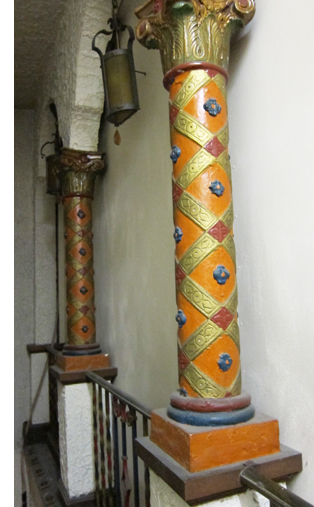 Leon Goetz was a risk-loving man. To build a 500-seat film theatre in a town with about 4500 people reflects not only the growing popularity of movies but a conviction that the business had a future. In addition, the many farms and little towns around would supply customers; Monroe is the county seat of Green County, so people came here to transact business as well as to shop. Then as now, the nearest competitors to a Monroe theatre were over twenty miles away.
Leon Goetz was a risk-loving man. To build a 500-seat film theatre in a town with about 4500 people reflects not only the growing popularity of movies but a conviction that the business had a future. In addition, the many farms and little towns around would supply customers; Monroe is the county seat of Green County, so people came here to transact business as well as to shop. Then as now, the nearest competitors to a Monroe theatre were over twenty miles away.
With his brother Chester as partner, Leon owned or managed other theatres in the area, including ones in Beloit and Janesville. The brothers’ biggest triumph, however, was building the Goetz Theatre. Opening on 2 September 1931, it was of semi-Moorish design, with faux balconies and moody cloud-and-star lighting on the ceiling. Light brown brick and darker brown terracotta inlays finished the outside. The lobby was forty feet high, with a gold finish and many trappings and fixtures.
Some unexpected innovations included seats equipped with earphones for the hard of hearing. The screen was 20 feet wide and fifteen feet tall. Accounts of the size range from 800 to 1000 seats. In all, the Goetz was said to have cost $125,000.
The Monroe had presented sound films using a system of Leon’s devising, but the Goetz was a step up, as the editors of the Monroe Evening Times indicated:
It should raise inestimably the respect with which talkies are looked upon locally and attract many persons who heretofore did not care to see pictures under the conditions in which they were shown.
The Goetz has run ever since. It’s said to be the oldest continuous family-operated movie house in the Midwest.
Leon retired to Florida but Chester stayed in the business, opening the Goetz Junior on Christmas day, 1936. It was “ultra modern,” as it advertised itself, with the Western Electric Mirrophonic sound system and using streamlined design elements, like glass brick. Holding only 275 seats, it sometimes showed films not screened at the Goetz across the street, but other times it would screen the same films–sometimes on the same night, with reels rushed back and forth.
Soon Chester had competition from the Chalet, a 500-seat house around the corner. According to local memory, Chester cut ticket prices and then bought the floundering Chalet as a third Goetz house. Chester’s sons Robert and Nathan joined the business. Under Robert’s leadership, their company built the Sky-Vu Drive-in in 1954, and it too has been running without interruption every summer.
The postwar decline in movie attendance may have hit the family’s circuit. The Chalet and the Goetz Junior closed. In the 1980s and 1990s two screens were added at the Goetz, but unlike most old theatres that went multi-screen, the venue wasn’t split up. The new houses were converted from adjacent retail spaces. Visit the Goetz today and you’ll see the original auditorium. There are fewer seats, but it’s still enormous, as you can see from the front.
The third generation
Robert “Duke” Goetz. Behind him, counterclockwise, pictures of Conrad Goetz, Nathan as a child, Robert as a child, young Chester, and John. In the center, Chester Goetz.
For many years the downtown theatre and the Sky-Vu have been managed by Robert “Duke” Goetz, Robert’s son. He has a masters degree in landscape architecture from Harvard, but he’s been running the family business. He does everything from programming the movies and designing the website to wrench-and-hammer work on the place. He’s worked on heating, carpentry, and acoustic matters. Talk with him and you’ll hear about the tough times small-town exhibitors have faced over the last two decades. I learned as well some pressures on exhibition that I never thought about.
Duke Goetz has a commitment to showmanship and quality of presentation. The Goetz website has old-fashioned razzle-dazzle, including neon colors. (Chester liked bright colors in his houses.) On another page of the site you’ll see this:
Last Friday I saw Duke tell a gaggle of teenagers to shut off their cell phones, and he watched to make sure they did. The same pursuit of a good movie experience shows in Duke’s special attention to sound. Convinced that DTS is the best sound system for his venues, he has outfitted his smaller auditoriums with hard-hitting speaker systems. He installed tip-back seats, stadium seating in one house, and one belt-driven projector for steadier images.
Despite the commitment to quality, and programming that brings in family fare matched to local tastes, business has been rocky. Duke recalls some high points: 1993, when Jurassic Park did spectacularly at both the Goetz and the Sky-Vu; 1998, when Titanic brought in as many as a thousand viewers a night; and 2002, his best year in recent memory. That year was an exceptional spike for the industry as a whole, with estimated admissions of 1.57 billion, so just about anything less looks like a decline. Kristin talks about this effect here.
Duke’s business stayed flat but solid until 2007, when both the drive-in and the downtown screen began to slump. Business flattened out at a lower level through 2011. The only bright spot this year was Twilight: Breaking Dawn; the midnight premiere drew about 150 customers, mostly high-schoolers.
A good night at all three indoor screens is 300-350 tickets, but the Sky-Vu can reliably draw many more. Duke recalls one evening when the drive-in had over 1100 customers and sold 114 handmade pizzas. Today, even with competition from another local drive-in, the Sky-Vu’s summer schedule bolsters the bottom line significantly.
Why the falling off in recent times? I had expected the standard macro-explanations: the internet, video games, etc. But Duke’s main rival, he believes, is sports. In a town like Monroe, high school sports are central to community life, so Friday night football and basketball games draw not only teens but parents. With the rise of women’s athletics, the middle and high schools schedule plenty of games across the weekend. Add in the fact that televised football in the fall breaks up Saturday (the UW Badgers) and Sunday afternoons (the Packers), and you have a client base that isn’t focused so much on movies. Even the Christmas-New Year corridor, normally a brisk business period, is likely not to help much this time. The New Year starts on a weekend, so that the Packers’ final game on Sunday and the Badgers in the Rose Bowl on holiday Monday will compete with Duke’s screenings.
After three tough years, Duke looks at things realistically. He hires part-time staff to project, sell concessions, and keep an eye on the house, so he’s his only full-time employee. He adds: “I have not been paid since August 2010.” Digital, he admits, is chancy in this business climate. “But without digital, I’m gone.”
Duke goes digital
Duke Goetz saw his first digital screening around 2000 at a convention of the National Association of Theatre Owners (NATO). What attracted him was the edge-to-edge screen brightness. Judging by what I saw on Friday (from down front), the 1.85 image in 35mm at the Goetz is quite sharp, but Duke had long been unhappy with the inevitable falling-off of light toward the edges of any film display. The tendency is exaggerated in anamorphic (2.40) films, which have become more common. And the bigger the screen, the greater the tendency toward a hot spot in the center. In addition, Duke liked the punchier color in digital.
So he was intrigued. “I’d have loved to have done it ten years ago.” But then there was still debate about trustworthy delivery systems (the Net? satellite?) and the cost was astronomical, about $125,000 per projector. Last summer, though, it became clear that the digital wave was cresting, and time was running out for 35mm film. Also running out were the plans for the Virtual Print Fee, whereby the studios partially subsidize the cost of a theatre’s changeover.
This fall Duke took the plunge, arranging for three new NEC projectors from companies and installers he’s known for years. His final analog shows were last weekend. On Monday all houses were closed. By Tuesday night, the Goetz was running a digital copy of New Year’s Eve, which it had run in 35mm only a couple days before. By this coming weekend, all the digital screens are expected to be in action. Duke isn’t going with 3D, partly because he can’t justify the upcharge and partly because he’s not convinced it attracts enough extra business.
I was there for the Friday night 35 shows, and I re-visited on Tuesday. The whole changeover was less dramatic than I expected. In two of the houses, the old projectors were simply moved aside and the new ones sat stolidly in their place.
The gigantic platters were stacked in the hallway.
Reels, rewinds, and splicers sat in corners. All of the 35mm projectors were relatively new, but now one is now in the lobby as a historical artifact.
Duke thinks that digital will be even better for the Sky-Vu. The big screen is a problem for dimness and edge-to-edge brightness, but it should respond well to a digital beam. An indoor screen is porous to allow sound through, but that means that some light is lost. A drive-in screen is solid and should reflect light better. The brilliance of the digital illumination should also help counter chronic drive-in problems like fog, ambient light, moonlit nights, and some flaws on the screen.
The Goetz attendance flattening is part of a larger trend. The box office of 2011 has been weak, and for several years the total domestic admissions have hovered between 1.3 and 1.5 billion. Box office takings are up chiefly because of raised ticket prices, particularly for 3D and Imax. Professional predictors are suggesting that this year’s ticket sales will end up about the same as last year’s.
It would be easy for us cinephiles to bemoan what happened between Sunday and Tuesday in Monroe, Wisconsin. We celebrate the look and feel of film, and we’d like to see old picture palaces become temples dedicated to 35mm. But we don’t pay the shipping and heating bills for those houses; we don’t dicker with bookers who won’t let us have prints when we need them. We like the idea of film surviving, but the practical people who actually deal with exhibition day by day can’t afford to satisfy our tastes.
And we purists would doubtless be scandalized at what film prints looked like when they made their way to the Goetz in the old days, six months or more after release. The Goetz Junior opened with Eddie Cantor’s Strike Me Pink nearly a year after it premiered in Manhattan. In April 1956 the Chalet was running a 1951 Roy Rogers movie. Take a time machine back to the 30s or 40s or 50s and you’ll probably watch a choppy, scratchy print. In comparison digital starts to look pretty good.
I’d like to see Duke succeed. Monroe’s theatre reminds me of the single screen of my childhood, Schine’s Elmwood in Penn Yan, New York. That theatre is long gone, so part of me hopes that somewhere a local movie house can still bring in the community–whether it’s showing film, 2K, Blu-ray, or vanilla DVD. When I was a boy, I wouldn’t have cared how those images got on the screen. In a town like Monroe, the theatre, and the neighborly spirit it represents, is as important as the emulsion. One item of evidence is my 1936 photo up top, taken from the Goetz website. Down past the Hollywood Inn, which I wish I could visit now, maybe you can make out the Goetz marquee: TODAY 2 BIG FEATURES IN GERMAN.
Duke closed out his 35mm shows on the worst weekend exhibitors had seen since fall 2008. Will digital bring Monroe area customers back? Once people realize that they will get high-quality presentation in their home town, perhaps they won’t drive half an hour to Freeport or an hour to Madison. But best not to prophesy. Duke realizes he’s taking the same sort of risk that Leon and Chester took when they built the Goetz at a price of what would be $1.7 million today. “My motto,” he says, “is go digital or die.”
This is the second in a series of entries on the conversion of filmmaking, distribution, and exhibition to digital formats.
Leon Goetz is also credited with producing at least two films, Ten Nights in a Bar Room (1931) and The Call of the Rockies (1931).
I thank Duke Goetz and Mrs. Robert Goetz for talking with me about the past and present of the family business. Other information comes from volumes of The Film Daily Yearbook and issues of The Monroe Evening Times of 1 September 1931; 23 December 1956; 22 October 1981; and 15 May 2001. Also very helpful was Pictorial History of Monroe, Wisconsin, ed. Matthew L. Figi (Green County Historical Society, 2006), supplemented by some discussion with Matt. Thanks also to the staff of the Monroe Public Library.
For better versions of the picture at the top of this entry and the frontal view further down, along with other high-quality images, go to the historical page of the Goetz Theatres site. A chronology of the Goetz Theatres is on this page, and some shots inside the booths at the Goetz 2 and 3 are here.
P.S. 15 December: Thanks again to Matt Figli, who spotted some inaccuracies in my account of Monroe’s history. They have been corrected.
P.P.S. 28 December: Katjusa Cisar’s story in The Monroe Times today brings us more information on the Goetz, both past and present.












